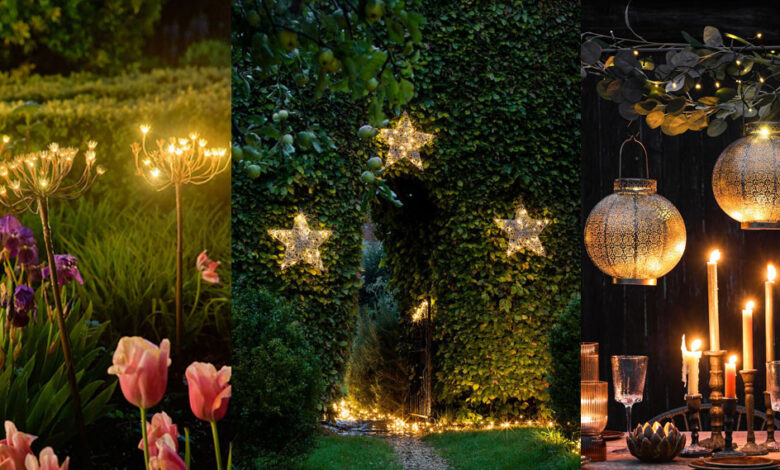Illuminating Your Space with Solar Lights: An Eco-Friendly Lighting Solution

As the world moves towards more sustainable living practices, solar lights have emerged as a popular and eco-friendly solution for outdoor illumination. These lights harness the sun’s energy during the day and convert it into electricity to power LED bulbs at night. Solar lights are not only environmentally friendly but also cost-effective and easy to install. This article explores the benefits of solar lights, the different types available, installation tips, and maintenance practices to help you make the most of your solar lighting system.
Benefits of Solar Lights
Environmentally Friendly
Solar lights are powered by renewable energy from the sun, reducing your carbon footprint and promoting environmental sustainability. By using solar lights, you contribute to the reduction of greenhouse gas emissions and dependence on fossil fuels.
Cost Savings
One of the most significant advantages of solar lights is the cost savings they offer. Since they rely on solar energy, there are no electricity costs associated with their operation. Additionally, solar lights require minimal maintenance, reducing long-term expenses.
Easy Installation
Solar lights are designed for easy installation without the need for complex wiring or electrical connections. This makes them an ideal choice for do-it-yourself projects and for locations where access to electricity is limited or nonexistent.
Energy Independence
Solar lights provide energy independence by generating their own power from the sun. This ensures that your outdoor spaces remain illuminated even during power outages, enhancing safety and security.
Low Maintenance
Solar lights have no moving parts and are built to withstand various weather conditions, requiring minimal maintenance. Most solar lights feature durable materials that resist rust and corrosion, ensuring long-lasting performance.
Versatile Applications
Solar lights are available in a variety of designs and styles, making them suitable for a wide range of applications. From garden pathways and driveways to patios and decks, solar lights can enhance the ambiance and functionality of any outdoor space.
Types of Solar Lights
Solar Path Lights
Solar path lights are designed to illuminate walkways, driveways, and garden paths. They are typically installed along the edges of paths to provide safe and attractive lighting. These lights come in various styles, from simple stakes to decorative lanterns, and are often equipped with sensors to automatically turn on at dusk and off at dawn.
Solar Spotlights
Solar spotlights are used to highlight specific features in your landscape, such as trees, shrubs, or architectural elements. They provide a focused beam of light and are adjustable to direct the light where it’s needed most. Solar spotlights are ideal for accentuating the beauty of your outdoor spaces while adding an element of security.
Solar Floodlights
Solar floodlights offer bright, wide-angle illumination for larger areas like driveways, patios, and yards. They are perfect for enhancing security and visibility around your property. Many solar floodlights come with motion sensors, activating the light when movement is detected to deter intruders and provide additional safety.
Solar String Lights
Solar string lights add a festive and decorative touch to outdoor spaces. They are perfect for patios, decks, pergolas, and gardens, creating a warm and inviting atmosphere. Solar string lights are available in various lengths, colors, and styles, allowing you to customize your outdoor lighting to suit any occasion.
Solar Wall Lights
Solar wall lights are mounted on exterior walls and provide functional and decorative lighting. They are ideal for illuminating entryways, staircases, and pathways, enhancing both safety and aesthetics. Solar wall lights come in a variety of designs, from modern to traditional, to complement any architectural style.
Solar Garden Lights
Solar garden lights are designed to be placed in flower beds, planters, and around garden features. They add a charming and whimsical touch to your landscape while providing functional lighting. These lights come in various shapes and sizes, including decorative figurines, stakes, and lanterns.
Installation Tips for Solar Lights
Choose the Right Location
For optimal performance, place your solar lights in locations that receive direct sunlight for most of the day. Avoid areas with excessive shading from trees, buildings, or other obstructions, as this can reduce the amount of sunlight the solar panels receive and affect the lights’ performance.
Proper Spacing
Ensure proper spacing between solar lights to achieve even illumination. For path lights, place them about 6 to 8 feet apart. For floodlights and spotlights, position them to cover the desired area effectively. Proper spacing enhances both the functionality and aesthetics of your lighting.
Secure Mounting
Securely mount your solar lights to prevent them from being knocked over or blown away by strong winds. Use stakes for path lights and wall mounts or brackets for wall lights. For string lights, ensure they are properly anchored to prevent sagging or damage.
Clean Solar Panels
Keep the solar panels clean to maintain their efficiency. Dust, dirt, and debris can accumulate on the panels and reduce their ability to absorb sunlight. Regularly wipe the panels with a damp cloth or use a mild soap solution for more stubborn dirt.
Check Battery Life
Solar lights are equipped with rechargeable batteries that store the energy collected by the solar panels. Over time, these batteries may lose their capacity to hold a charge. Check the batteries periodically and replace them as needed to ensure optimal performance.
Test and Adjust
After installing your solar lights, test them to ensure they are functioning correctly. Adjust the positioning of the lights if necessary to achieve the desired illumination. Make sure sensors, if any, are properly aligned and responsive.
Maintenance Practices for Solar Lights
Regular Cleaning
Clean the solar panels and light fixtures regularly to ensure maximum efficiency and brightness. Remove any dirt, dust, or debris that may obstruct the panels or diminish the light output.
Inspect for Damage
Periodically inspect your solar lights for any signs of damage or wear. Check for cracked or broken panels, corroded connections, or damaged fixtures. Promptly repair or replace any damaged components to maintain the integrity of your lighting system.
Battery Replacement
Solar light batteries typically last for 1 to 2 years, depending on usage and environmental conditions. Monitor the performance of your lights and replace the batteries when you notice a significant decrease in brightness or operating time.
Winter Care
In colder climates, solar lights may require extra care during the winter months. Snow and ice can cover the solar panels, reducing their efficiency. Gently brush off any snow and ensure the panels remain exposed to sunlight. If necessary, bring portable lights indoors during extreme weather conditions.
Conclusion
Solar lights are a practical, cost-effective, and eco-friendly solution for outdoor lighting. By understanding the benefits, types, installation tips, and maintenance practices, you can make the most of your solar lighting system. Embrace the power of the sun to illuminate your outdoor spaces, enhance your property’s aesthetics, and contribute to a more sustainable future. Whether you need path lights, spotlights, floodlights, string lights, wall lights, or garden lights, solar-powered options offer versatility and reliability for all your lighting needs.



